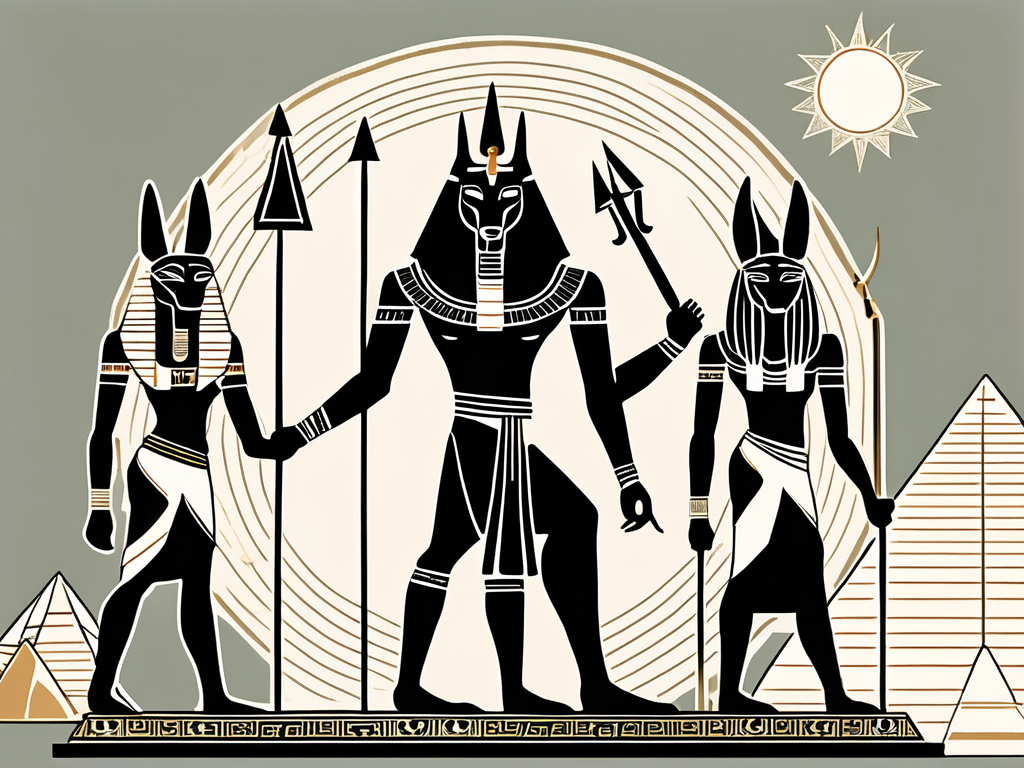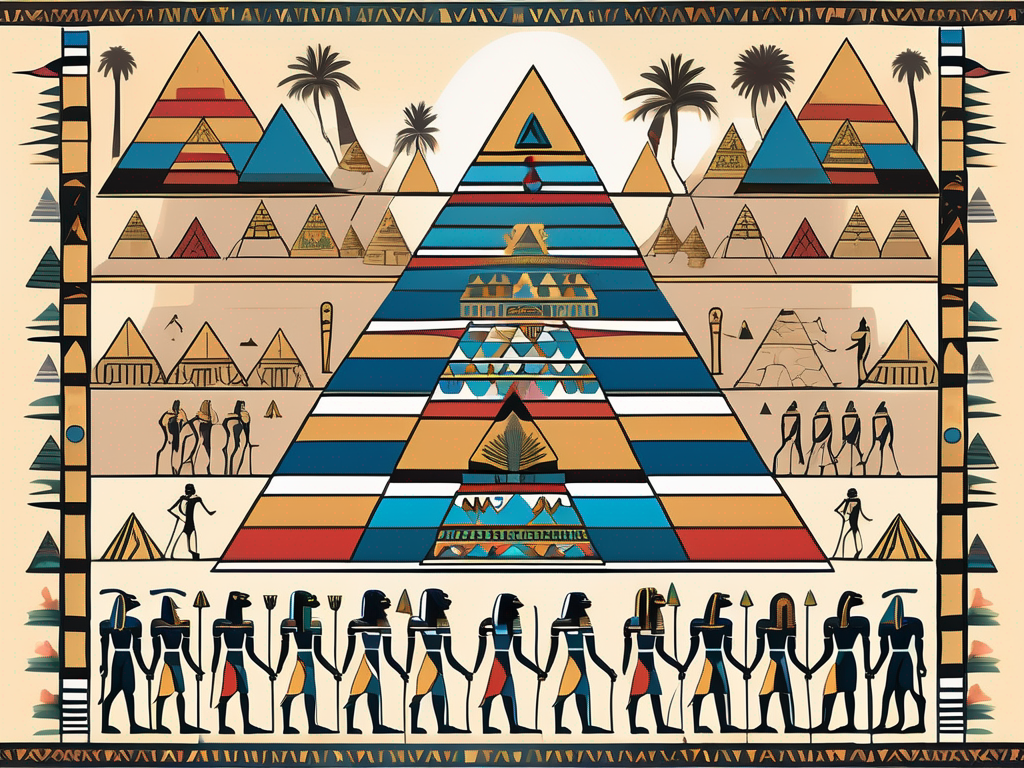In the rich tapestry of ancient Egyptian mythology, Imsety stands as a prominent figure, revered as the god of mummification and healing. His significance within the pantheon extends beyond his association with death and preservation; Imsety’s healing powers were also sought after by the ancient Egyptians. Let us delve into the mythology, iconography, rituals, and legacy of Imsety to uncover the enigmatic world of this divine figure.
Understanding the Role of Imsety in Ancient Egyptian Religion
Imsety occupied a pivotal role in the complex religious system of ancient Egypt, where gods and goddesses reigned supreme. As one of the Four Sons of Horus, Imsety embodied the ideals of the afterlife and the circle of life. In their belief system, the ancient Egyptians aspired to navigate the arduous journey after death and achieve immortality. Imsety played a central role in this quest, offering both physical preservation and spiritual healing.
The Mythology of Imsety
According to ancient Egyptian myths, Imsety was born to the sky goddess Nut and the earth god Geb, making him a descendent of divine lineage. It was believed that he watched over the viscera jars, which contained the vital organs of the deceased after the mummification process. Imsety’s duty was to protect and ensure the organs remained intact, allowing the deceased to assume a new life after death.
Imsety’s role as the guardian of the viscera jars was not only a physical responsibility but also held deep spiritual significance. The ancient Egyptians believed that the organs were essential for the soul’s journey in the afterlife. Imsety’s presence ensured that the deceased would be able to navigate the treacherous realms and successfully reach their eternal destination.
Furthermore, Imsety’s connection to Nut and Geb highlighted his divine heritage and emphasized his importance in the cosmic order. As the son of the sky and earth, Imsety embodied the balance between the heavens and the earthly realm, symbolizing the harmonious union necessary for the continuation of life.
Imsety’s Association with Mummification
Mummification held great importance in ancient Egyptian culture as it was believed to facilitate the soul’s journey to the afterlife. Imsety’s association with this meticulous and sacred practice elevated his status in the minds of the ancient Egyptians. Through the removal and preservation of organs, Imsety ensured the deceased could maintain their bodily integrity in the afterlife, enabling them to enjoy the rewards and blessings of eternity.
The process of mummification was a complex and intricate one, involving various rituals and ceremonies. Imsety’s presence during this process was seen as a divine intervention, ensuring that the deceased would be able to embark on their journey to the afterlife with a preserved and intact body. The ancient Egyptians believed that without Imsety’s protection, the organs would decay, and the soul would be left vulnerable and unable to complete its journey.
Imsety’s role in mummification extended beyond the physical preservation of the organs. It was believed that he also imbued the organs with spiritual power, enabling the deceased to access the necessary energy and vitality needed in the afterlife. This spiritual aspect of Imsety’s role further emphasized his importance in the eternal journey of the soul.
Imsety’s Healing Powers
Imsety’s influence extended beyond the realm of mummification. As the god of healing, he possessed the ability to restore health and vitality to both mortals and gods alike. Ancient Egyptians bestowed their trust in Imsety to cure ailments and alleviate suffering. Temples dedicated to Imsety were built, where priests and priestesses carried out divine rituals and offered prayers to seek his benevolent intervention on behalf of those in need.
Imsety’s healing powers were not limited to physical ailments but also extended to the spiritual and emotional well-being of individuals. It was believed that he could provide comfort and solace to those who were suffering, offering a sense of peace and tranquility in times of distress. The ancient Egyptians turned to Imsety in times of sickness, seeking his guidance and assistance in their quest for healing and wholeness.
Moreover, Imsety’s association with healing also highlighted the interconnectedness between the physical and spiritual realms. The ancient Egyptians believed that true healing could only be achieved when both the body and soul were in harmony. Imsety’s role as the god of healing emphasized the importance of addressing both the physical and spiritual aspects of an individual’s well-being.
The Iconography of Imsety
Within ancient Egyptian art, Imsety was frequently depicted in a distinctive manner that emphasized his role and significance. These depictions shed light on the symbolic attributes associated with Imsety, enabling us to unravel the complexities of his character.
Imsety, one of the four sons of Horus, played a crucial role in the afterlife journey of the deceased. His depictions in ancient art not only showcased his physical appearance but also conveyed deeper meanings and symbolism.
Depictions of Imsety in Ancient Art
Artistic representations of Imsety usually portrayed him as a mummified man with a human head, donning a nemes headdress adorned with the royal uraeus. This distinctive headdress symbolized his connection to royalty and divine authority. Surrounding him were the viscera jars, symbolizing his guardianship over the vital organs.
The meticulous attention to detail in these artistic representations is remarkable. Imsety’s mummified form was depicted with great precision, showcasing the intricate bandages that enveloped his body. The careful rendering of these bandages not only demonstrated the ancient Egyptians’ skill in artistry but also emphasized Imsety’s role as a protector of the deceased.
Imsety’s facial features were also meticulously depicted, with his human head displaying a serene expression. The eyes, delicately outlined, conveyed a sense of wisdom and compassion, reflecting Imsety’s role as a guardian and guide in the afterlife.
Symbolism and Attributes of Imsety
Beyond his physical appearance, Imsety’s symbols further elucidate his divine qualities. The hieroglyphic symbols associated with Imsety included a human-headed canopic jar, which represented his duties in preserving the organs. This canopic jar was not only an emblem of Imsety’s affiliation with mummification but also a potent symbol of resurrection and eternal life.
The canopic jars, carefully crafted and intricately decorated, were believed to house the vital organs of the deceased. Imsety’s responsibility was to protect and preserve the liver, ensuring its safe passage into the afterlife. The presence of these canopic jars in artistic depictions of Imsety emphasized his role as a guardian of life and death.
Imsety’s association with mummification and the preservation of organs also reflected the ancient Egyptians’ belief in the importance of bodily integrity in the afterlife. By ensuring the proper preservation of the deceased’s organs, Imsety played a crucial role in facilitating their journey to the realm of the gods.
Furthermore, the canopic jar symbolized the concept of rebirth and the eternal cycle of life. Imsety’s presence in these depictions served as a reminder of the cyclical nature of existence and the belief in the continuity of the soul beyond death.
In conclusion, the depictions of Imsety in ancient Egyptian art not only captured his physical appearance but also conveyed profound symbolism and meaning. Through these artistic representations, we gain insight into Imsety’s role as a protector, guide, and preserver of life in the afterlife. The meticulous attention to detail and the inclusion of symbolic elements such as the canopic jars further enrich our understanding of Imsety’s significance in ancient Egyptian mythology and religious beliefs.
Imsety in the Context of the Egyptian Pantheon
Imsety’s presence within the Egyptian pantheon extends beyond his individuality. Understanding his relationships with other gods and his role alongside the Four Sons of Horus can offer deeper insights into his significance to ancient Egyptians.
Imsety’s Relationship with Other Gods
As a divine entity, Imsety’s connections with other gods were crucial in the intricate tapestry of Egyptian mythology. His relationship with Isis, the goddess of magic and healing, highlights the synergy between their powers of restoration. Together, their combined influence offered hope and solace to those seeking healing and rejuvenation.
The Four Sons of Horus: Imsety’s Role and Significance
The Four Sons of Horus, including Imsety, were revered not only as individual deities but also as a collective force. Imsety’s association with Hapi, Duamutef, and Qebehsenuef, the other sons of Horus, formed a powerful quartet representing different aspects of the divine afterlife. As a group, the Four Sons of Horus embodied the eternal cycle of life and death, offering guidance and solace to those navigating the perilous journey of the afterlife.
Rituals and Worship of Imsety
Throughout ancient Egypt, worship and devotion to Imsety encompassed various rituals and practices. These customs manifested the profound faith the ancient Egyptians held in Imsety’s powers of healing and preservation.
Ancient Egyptian Practices and Beliefs
Imsety’s worship involved offerings, prayers, and rituals performed by priests and devotees in temples and homes alike. Offerings such as food, incense, and wine were presented to appease and invoke the god’s favor. Imsety’s priests, responsible for administering healing practices, had a significant role in the spiritual welfare of both the living and the deceased.
Imsety’s Influence on Modern Practices
The veneration of Imsety has transcended the ancient world and continues to inspire modern understandings of healing, preservation, and spirituality. The legacy of Imsety can be seen in various forms, from the fascination with ancient Egyptian traditions to its influence on contemporary art, literature, and popular culture. Imsety’s enduring presence serves as a testament to the enduring power of mythology and its ability to shape our perception of the divine.
The Legacy of Imsety
Imsety’s impact on Egyptian culture and society extends far beyond his role as the god of mummification and healing. By examining the everlasting impressions he has made, we can uncover the depth of his legacy.
Imsety’s Impact on Egyptian Culture and Society
Imsety’s association with mummification provides us with profound insights into the ancient Egyptian attitude toward death and the afterlife. The meticulousness of the mummification process, guided by the presence of Imsety, reflects the Egyptians’ unwavering commitment to preserving their corporeal form and ensuring their eternal existence in the realms beyond.
Imsety in Modern Interpretations and Media
Imsety’s presence in modern interpretations of ancient Egyptian mythology showcases his ongoing relevance and fascination. From books and movies to artwork and exhibitions, Imsety’s image and significance continue to captivate audiences, introducing the intriguing world of Egyptian gods and goddesses to new generations.
Conclusion
Imsety, the Egyptian god of mummification and healing, holds a significant place in the pantheon of ancient Egyptian deities. His role as a guardian and preserver of the deceased, as well as his healing powers, symbolize the ancient Egyptians’ quest for eternal life and their belief in the interconnectedness of life, death, and rebirth. Through mythology, iconography, rituals, and modern interpretations, Imsety’s legacy endures, offering us a glimpse into the profound spirituality of the ancient Egyptian civilization.












